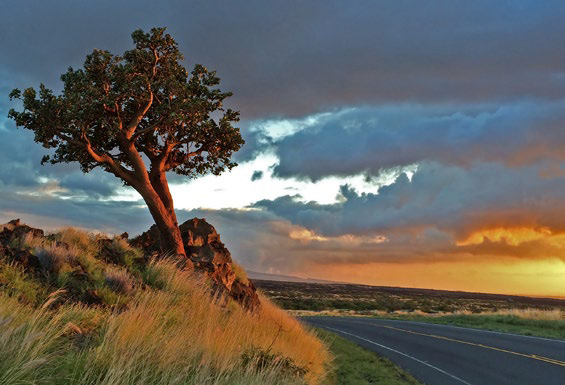Hawai`i Island’s natural beauty is largely maintained by thoughtfully planned developments. There’s no vast, uncontrolled sprawl of homes and buildings, but rather what strikes the eye are master-planned resorts nestled by the coast with open countryside rising to towering green mountains behind.
And while the beaches and mountains have starring roles in this unique landscape, the drier, lower elevations play host to a number of endemic flora species — many of which have important cultural ties — including the beloved wiliwili tree.
Once common on the terrain now occupied by Waikoloa Resort’s golf courses and the dry forest areas surrounding Waikoloa Village a few miles mauka, the lands on which the wiliwili trees thrived became degraded over time by invasive plants, fire, illegal dumping, and ungulates (hooved animals such as goats, pigs, and cattle) which ate the trees’ bark and leaves.
Learn more and get involved with this restoration initiative. WaikoloaDryForest.org
PRESERVE, PROTECT, AND RESTORE
Waikōloa Dry Forest Initiative, a group whose mission is to “protect, promote, and restore a remnant native Hawaiian dry forest ecosystem through land management, outreach, education and grass roots advocacy,” was founded in 2011 by a group of concerned Waikoloa residents, including members of the Outdoor Circle. The group procured a 75-year lease on 275 acres from the Waikoloa Village Association to create a sanctuary where the wiliwili trees and other dry forest species could be protected and restored.
Located just southwest of Waikoloa Village, the land was fenced off, and restoration work was begun. “The fence helped keep the ungulates out,” says Jen Lawson, Executive Director of Waikoloa Dry Forest Initiative. “That was the first important step.”
Next, a squad of volunteers started working on cleaning up the land, and readying it for replanting. “Wiliwili trees were populous on the island at one time,” Lawson says, “but we lost about half of the entire population here in Waikoloa just in the last 13 years, and more than half of historic populations.”
Nowadays, the trees are making something of a rebound. “We’ve been chipping away,” she says, “planting five acres at a time. There are now some 50 acres cleared and replanted. Community volunteers come out twice a month to plant trees. Hundreds of volunteers help do the things that need doing to restore the area.”
At the same time, successful biocontrol measures were introduced by state science officers to counteract the negative impact of a certain microscopic wasp species that was killing the trees, a move Lawson says, “saved the day for our trees.”
And while new wiliwili trees are taking hold, Lawson says many of the kapuna (older) trees are simply dying of old age: “The numbers have improved because of planting, but we’re losing some of the kupuna trees. They live around 300 years we believe, and many are getting there. We’re still able to collect lots and lots of seeds, so hopefully by the time the old ones are gone, the keiki (new) trees will be able to reproduce on their own.”
EDUCATING FUTURE GENERATIONS
Under Lawson’s guidance, education about the Waikōloa Dry Forest Initiative has been a major goal. To that end, the road to the dry forest was recently improved, and the Hale Hana Hou pavilion was completed in 2017. The public is invited to come out by reservation, or for organized events such as talk story evenings, First Friday hikes, and volunteer days. “It’s a place to learn, a place to enjoy,” Lawson says.


A field biologist by training, Lawson says the group’s goal is to one day have the preserve open for self-guided tours. For the time being, though, with only three full-time employees, “We try to accommodate people as much as we can,” she says. “We interact with all the schools, and our Future Foresters Program brings kids in every Saturday.” “Our education programs have really grown in the past few years,” she says. “We started an after-school program three days a week where we teach the kids ornithology, botany, life sciences, the role of the watershed, the role of trees … not just in the dry forest, but all over the island. The kids really become connected to the place they live. That’s really why we do it.”
Lawson reports that not only do the kids get excited, but they take the knowledge they gain at the dry forest home and share it on a family and community-wide basis. And during the annual Wiliwili Festival (February 8, 2020) “the kids get to be the experts,” she says.
In terms of fundraising, “Culinary Arts Under the Stars” is one of the biggest events of the year. Held at Kings’ Shops in January, the sold-out 2020 event raised more than $15,000 for the Waikōloa Dry Forest Initiative.
CULTURAL SIGNIFICANCE
 In addition to biodiversity, “The wiliwili tree was significant in Hawaiian culture, so it’s important that it survive,” Lawson says. “The wiliwili tree is super light, and was used in making the ama (float) on outrigger canoes and surfboards.”
In addition to biodiversity, “The wiliwili tree was significant in Hawaiian culture, so it’s important that it survive,” Lawson says. “The wiliwili tree is super light, and was used in making the ama (float) on outrigger canoes and surfboards.”
Legendary Hawaiian surfer, surf historian, and Olympian Duke Kahanamoku (1890-1968) once noted that the olo (18-24 feet long) board designs of the old Hawaiian ali`i were often made from the wood of wiliwili trees. The wood is also used by some contemporary artists in the making of replica surfboards and other creations.
Though the task of restoring the dry forests of Waikoloa is a big one, Lawson is optimistic. “I tell the school kids who come and visit us here that, ‘If something is bothering you in the environment, do something about it!’” she says. With positive examples like Lawson and the Waikōloa Dry Forest Initiative leading the way, the future for Hawai`i’s keiki — both human and tree — has been planted.

